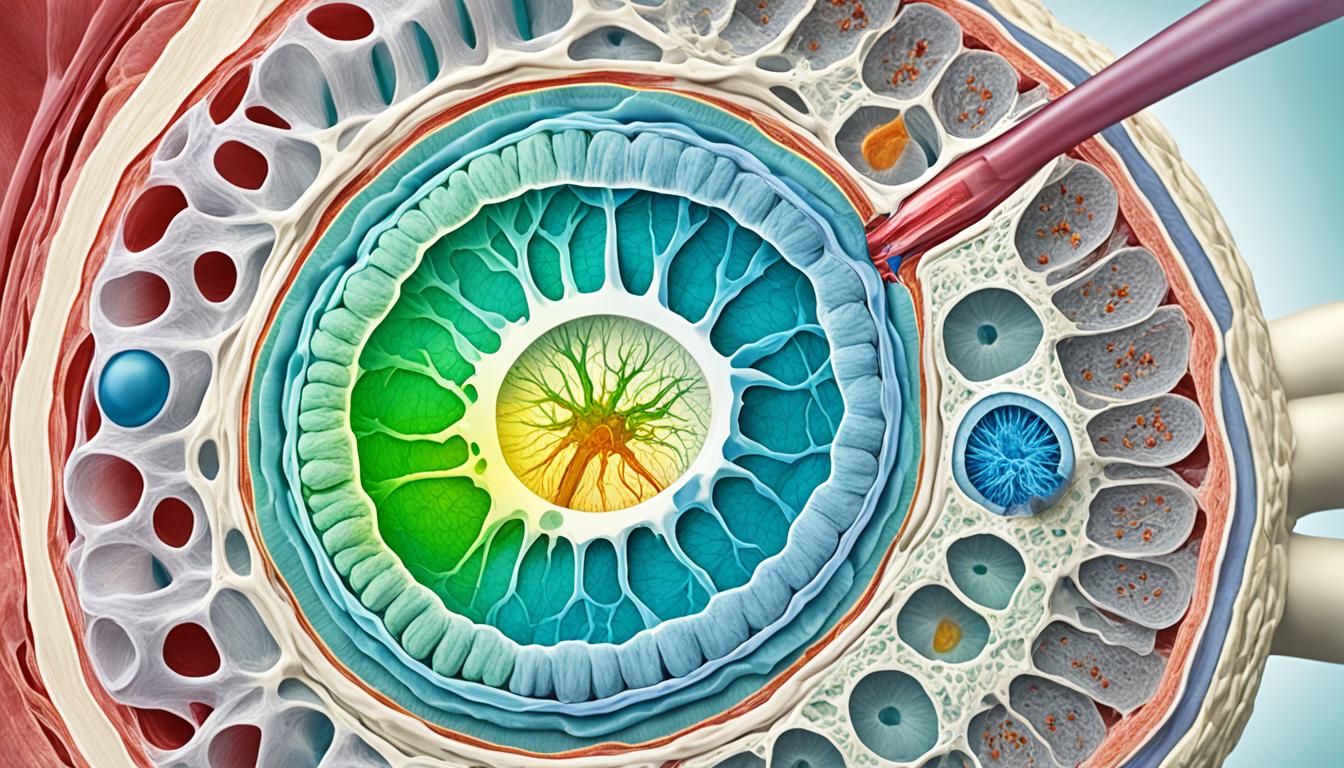A herniated disk is a common spine injury. It’s also known as a slipped or herniated disc. It happens when a spinal disc’s soft inner material bulges or leaks through its tough outer layer. This puts pressure on nerves nearby, causing problems like back pain, sciatica, and weakness. Age, genetics, obesity, and smoking are key causes of herniated discs.
For diagnosing a herniated disk, doctors perform a physical exam and may use imaging tests like an MRI. They might also do a discography for more insights. Treatment usually starts with meds and physical therapy. But severe cases may need surgery. Recently, stem cell therapy has shown promise in treating this condition. It aims to regenerate tissue and lessen symptoms by injecting stem cells right into the damaged disc.
Key Takeaways:
- Herniated disk, also known as slipped or herniated disc, is a common injury to the spine.
- Compression of nearby nerves can cause symptoms such as back pain, sciatica, and weakness.
- Herniated discs can be caused by various factors, including age, genetics, obesity, and smoking.
- Diagnosis includes physical examination, imaging tests, and further testing like discography.
- Traditional treatment options include medication, physical therapy, and surgery.
- Stem cell therapy is an innovative alternative that promotes tissue regeneration and symptom relief.
How Stem Cell Therapy Works for Herniated Discs
Stem cell therapy is a new way to treat herniated discs. These cells can grow into different types of cells in our bodies. This includes the ones in our intervertebral discs, like those found in nucleus pulposus.
During the therapy, stem cells are injected right into the damaged disc. Doctors use advanced imaging to be very precise. This means they can target the problem area directly.
This image shows how stem cell therapy is done. It is not very invasive, and it targets the issue carefully.
After the injection, stem cells start to repair the damaged tissue. They help in growing new cells and fixing the disc. This can reduce pain and make the disc work better.
One big benefit of this therapy is that it’s not very invasive. So, it needs less care after and you recover faster than with surgery. Patients often see their symptoms get better quickly so they can go back to their regular life sooner.
Many studies have shown that stem cell therapy can really help with herniated discs. People feel less pain and can do more. Because of these good results, more research is being done about using stem cell therapy for other back problems.
Potential Future Applications of Stem Cell Therapy
Stem cell therapy is still new, but it could do a lot in the future. Researchers are working on many ways to make this therapy even more helpful. They want to find new methods to use stem cells.
One idea is to inject platelet-lysate, which is full of growth factors. This could help discs heal better. The goal is to increase what stem cells can do and make patients’ outcomes better.
There is also talk about making pluripotent stem cells grow into cells like those in our discs. With enough of these cells, more people could get this therapy. This could really change how we treat back problems.
Researchers also want to learn more about where stem cells live in our discs. This could lead to new ways to heal our discs. Making stem cell therapy work even better would be a big win for patients.
Stem cell therapy keeps getting better as we learn more. In the future, it could be a very effective way to treat herniated discs. With more study and new ideas, we could help a lot of people.
| Benefits of Stem Cell Therapy for Herniated Discs | Future Possibilities of Stem Cell Therapy for Herniated Discs |
|---|---|
|
|
Benefits and Future Possibilities of Stem Cell Therapy for Herniated Discs
Using stem cell therapy for herniated discs can bring several good things. It can offer long-term pain relief. It may also reduce nerve issues, and lower the swelling in the spinal cord.
The stem cells’ ability to heal damaged areas is key. They work to fix the damage and help grow fresh, healthy tissue. This could make the disc work better and stop it from getting worse.
Stem cell therapy is also great because it’s not very invasive. Patients need less care after the procedure and get back on their feet quickly. This means they don’t have to stay in the hospital long and can go back to their normal lives soon. It gives hope to those looking for a treatment with fewer issues.
The future of treating herniated discs looks very promising with these new treatments. Researchers are looking into ways to make stem cell therapy even better. They’re trying things like injections that let out special proteins to help the disc heal. They also work on turning other types of stem cells into disc cells, and figuring out where stem cells live in the disc.
All these steps aim to make the treatment work better, help the disc repair, and grow again. So, future treatments look brighter with these new ideas.

